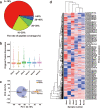Differential proteomics of placentas reveals metabolic disturbance and oxidative damage participate yak spontaneous miscarriage during late pregnancy
- PMID: 35761325
- PMCID: PMC9235108
- DOI: 10.1186/s12917-022-03354-w
Differential proteomics of placentas reveals metabolic disturbance and oxidative damage participate yak spontaneous miscarriage during late pregnancy
Abstract
Background: High spontaneous miscarriage rate in yak, especially during late pregnancy, have caused a great economic loss to herdsmen living in the Qinghai-Tibet plateau. However, the mechanism underlying spontaneous miscarriage is still poorly understood. In the present study, placenta protein markers were identified to elucidate the pathological reasons for yak spontaneous miscarriage through isobaric tags for relative and absolute quantification (iTRAQ) proteomic technology and bioinformatic approaches.
Results: Subsequently, a total of 415 differentially expressed proteins (DEPs) were identified between aborted and normal placentas. The up-regulated DEPs in the aborted placentas were significantly associated with "spinocerebellar ataxia", "sphingolipid signalling", "relaxin signalling", "protein export", "protein digestion and absorption" and "aldosterone synthesis and secretion" pathway. While the down-regulated DEPs in the aborted placentas mainly participated in "valine, leucine and isoleucine degradation", "PPAR signalling", "peroxisome", "oxidative phosphorylation", "galactose metabolism", "fatty acid degradation", "cysteine and methionine metabolism" and "citrate cycle" pathway.
Conclusions: The results implied that the identified DEPs could be considered as placental protein markers for yak miscarriage during late pregnancy, and biomacromolecule metabolic abnormality and oxidative damage might be responsible for the high spontaneous miscarriage rate in yak. These findings provide an important theoretical basis for deciphering the pathologic mechanism of late spontaneous miscarriage in yak.
Keywords: Abortion; Metabolism; Oxidative stress; Placenta; Proteomics; Yak; iTRAQ.
© 2022. The Author(s).
Conflict of interest statement
The authors declare no conflict of interest. The funders had no role in the design of the study; in the collection, analyses, or interpretation of data; in the writing of the manuscript; or in the decision to publish the results.
Figures





References
-
- Spencer T, Johnson G, Bazer F, Burghardt R. Fetal-maternal interactions during the establishment of pregnancy in ruminants. Soc Reprod Fertil Suppl. 2007;64:379–396. - PubMed
MeSH terms
Grants and funding
- 2020-QY-218/Science and technology plan of Qinghai Province
- 2020-QY-212/Science and technology plan of Qinghai Province
- CARS-37/China Agriculture Research System of MOF and MARA
- 25-LZIHPS-01/Innovation Project of Chinese Academy of Agricultural Sciences
- 1506RJZA159/Gansu Natural Science Foundation of China
LinkOut - more resources
Full Text Sources

